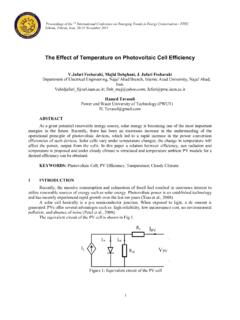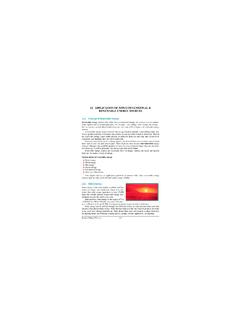Transcription of Solar Thermal Systems
1 TramStore21 Report Building sustainable and efficient tram depots for cities in the 21st century Solar Thermal Systems TramStore21, 2012 TramStore21 | Solar Thermal Systems 2 ContentsContents .. 2 Contacts TramStore21 partners .. 3 4 Applications by partners .. 7 Blackpool Council .. 7 Grand DIJON .. 8 STIB ..16 External applications ..17 Southern African Solar Thermal Training and Demonstration Initiative ..17 Key Points & Recommendations ..18 Contacts TramStore21 partners This is a list of experts on this issue, within five TramStore21 partnership organisations. You may contact each person directly to get expert feedback. Name Organisation Function or Department Email Telephone Kathrin Hesse Fraunhofer IML Department of Logistics, Section of Environment @ +49 231 9743 364 Joseph D rmann Fraunhofer IML Department of Logistics, Section of Construction @ +49 231 9743 377 Lionel Thi bault STIB Energy and HQE officer.
2 Infrastructures thiebaultl@ +32 2 563 71 35 Koos Spindler RET/ Spindler Design to Build spindler@ +31 651 24 94 67 Rem de Tender RET Beverwaard officer +31 10 447 5541 Phil Nixon Blackpool Council Senior Project Manager @ +44 1253 476072 Olivier Henry Grand Dijon Soci t d'Economie Mixte d'Am nagement de l'Agglom ration Dijonnaise ohenry@ +33 3 80 72 90 56 Sophie Mirlicourtois Grand Dijon/ CSD Ing nieurs Ing nieur d tudes Environnement et Construction @ +33 4 72 76 06 90 TramStore21 | Solar Thermal Systems 4 Introduction The incidence of radiation energy on the continents by the sun amounts to upto 219,000,000 billion kWh per year. This corresponds to the 2500-fold of the present world energy Figure 1: Solar Thermal System2 A Solar Thermal system converts sunlight into heat and consists of the following components: collector storage technology ( boiler, combined storage) Solar regulator system ( temperature difference control) The key element of Solar Thermal system is the Solar Thermal collector , which absorbs Solar radiation.
3 The purpose of the collector is to convert the sunlight very efficiently into heat. Solar heat is transmitted to a fluid, which transports the heat to the heat exchanger via pumps with a minimum of heat loss. The exchanger transfers the heat into the domestic hot water store. The distance between collector and storage tank should be as short as possible to minimise heat loss. There are two Solar Thermal Systems : Solar heating system to produce hot domestic water 1 AEE- Institut f r Nachhaltige Technoloien; Gottfried Purkarthofer, Technologieportrait Solarthermie 2 (last visited 07-03-2012) TramStore21 | Solar Thermal Systems 5 Solar power system as supplementary heating Figure 2: flat - plate -collector3 Figure 3: Evacuated-tube-collector4 Two main types of Solar Thermal collectors are available: the evacuated-tube collector and the flat - plate collector .
4 An evacuated-tube collector is made of parallel glass tubes. Each tube contains two glass tubes: the outer glass tube and the inner glass tube. Between the two glass tubes there is a vacuum which allows small heat loss. The absorber is included in a tube. The flat - plate collector consists of an insulated (bottom and side) box with a glass or plastic cover on the top and a Solar absorber located at the bottom. Almost 90% of all collectors in Germany are flat - plate collectors. Table 1: Comparison of evacuated-tube and flat - plate collector Evacuated-Tube collector flat - plate collector Very expensive Price below evacuated-tube collector Air is evacuated elimination of heat loss Air is not evacuated heat loss Can achieve high temperatures (77-177 C (170-350 F)) high efficiency Lower temperature can be achieved (30-70 C (86-158 F)) 3 (last visited 07-03-2012) 4 (last visited 07-03-2012) TramStore21 | Solar Thermal Systems 6 For cloudy and freezing climates Simple construction About million square meters of collector space have recently been installed in Germany (2008).
5 The total collector area in Germany is about million square metres (end of 2008). The total capacity amount is giga watt in Germany (end of 2008) whereof mega watt were the capacity of newly installed collectors in 2008. Our current research shows that projects of Solar Thermal energy are being realised mainly in the private sector. The activities of the commercial sector focus on potential analysis and studies in particular. Figure 4: Share of the EU Solar Thermal market 20085 In the light of climate change and rising gas and oil prices, the Solar Thermal market in the EU and Switzerland had a growth by 60% to GWth of new capacity, million m2 of collector area in 2008. In Germany the demand for Solar Thermal technology has more than doubled and has also grown strongly in smaller 5 Solar Thermal Markets in Europe - Trends and Market Statistics 2008 (ESTIF), May 2009 TramStore21 | Solar Thermal Systems 7 Applications by partners Blackpool Council Remarks Solar heating The detrimental issues surrounding roof mounted photovoltaic panels also apply to the provision of Solar heating installations in that the high winds containing salt spray and abrasive sand would both impair the efficiency of the units and reduce their lifespan.
6 This would make this potential sustainable energy provider an unfavourable option at Starr Gate tram depot, as it would greatly increase the payback period for such an installation. TramStore21 | Solar Thermal Systems 8 Grand DIJON Description Justification of choice for this project The following elements of the project of Grand Dijon made it possible to retain the choice of Solar collectors for the production of sanitary warm water: the need for sanitary warm water is constant throughout the year available surface allows the installation of Solar panels, directed and inclined in a optimal way reduction of fossil energy consumption by Solar energy utilisation Presentation of installation The production of sanitary warm water for the workshop buildings is guaranteed by Solar collectors installed on the roof coupled to the gas generator with a suction cup.
7 The main features of the Thermal Solar installation are as follows: entire surface installed: 9,2 square metres number of collectors: 4 collector type: Vitosol 200F by VIESSMANN (or a technical equivalent) orientation: south inclination: 35 Solar tank: 500l, type VITOCELL 100-V CVA by VIESSMANN auxiliary tank: 230l tank with gas and a horizontal suction cup TURBO type SANIGAZ 230-18 by Atlantic-Guillot The simulations of Solar production of sanitary warm water allowed the design of this installation and provided the following results: cover rate of needs: 50% annual productivity: 533 kWh/square metre 150 kg to 250 kg equivalent CO2 avoided by the collector per square metre and year TramStore21 | Solar Thermal Systems 9 Operation and guarantees A SGR, Solar Guarantee of Results , is being carried out.
8 SGR results in a collaboration of technical operators of the project: the manufacturer of Solar collectors, the fitter and owner assisted by their technical engineers. They jointly guarantee a minimum level of annual supply of Thermal kWh of Solar origin for 3 to 5 years. During this period, the real production of the installation must be at least 90% of the calculated production. If this agreement is not respected, a compensatory allowance has to be paid to the customer. The Solar installation is equipped with a device that allows remote monitoring which makes the counting of monthly Solar energy possible. This possibility of constantly supervising the performance of the installation was an obligation. The Solar installation is thus provided with a tele-controller connected to the phone network, which immediately informs the person in charge of operation failures or faulty devices during the installation.
9 Maintenance The maintenance happens periodically (two visits per year) and continuously helps to extend the life span of the equipment. Figure 5: Installation of Solar collectors Key figures The following check-ups need to be done when examining the equipment: Solar COLLECTORS general visual monitoring of the collectors (broken windows, deterioration of joints or insulation) and cleaning control purging of the collectors controlling the temperature of each battery exit of the collectors TramStore21 | Solar Thermal Systems 10 checking the position of the balancing valves TECHNICAL PREMISE: pressure of the primary education circuit to complement antifreeze operation of the relief valve of primary education circuit statements about the temperature of the exchanger and (X) balloon (S)
10 Measure of differential pressure of primary education circulator operation of the valves operation of the sanitary valves functional check of the volumeters absence of escapes and abnormal noises inversion of the engines of double circulators of primary and secondary education measure of the flow of primary education circuit control of vent cocks, surge tank and anodes Experiences In low energy consumption buildings the production of sanitary water has become a major source of energy consumption. In fact, the efforts made to reduce the heating energy have to be extended to other energy items, like the production of warm sanitary water. The use of renewable energy for warm sanitary water production is necessary to reduce the environmental impact of the building.


